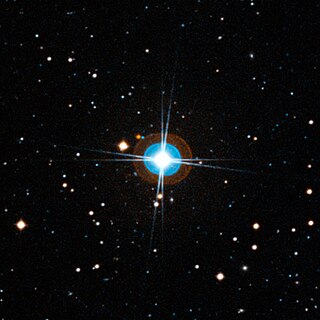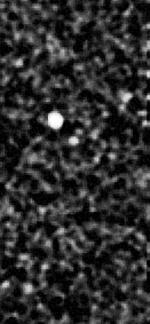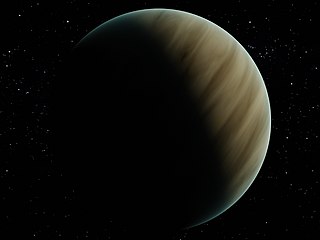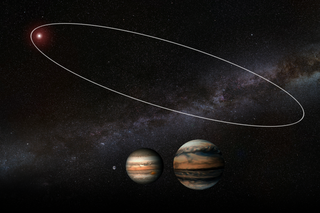Related Research Articles

Hot Jupiters are a class of gas giant exoplanets that are inferred to be physically similar to Jupiter but that have very short orbital periods. The close proximity to their stars and high surface-atmosphere temperatures resulted in their informal name "hot Jupiters".

54 Piscium is an orange dwarf star approximately 36 light-years away in the constellation of Pisces. In 2003, an extrasolar planet was confirmed to be orbiting the star, and in 2006, a brown dwarf was also discovered orbiting it.

An eccentric Jupiter is a Jovian planet that orbits its star in an eccentric orbit. Eccentric Jupiters may probably disqualify a planetary system from having Earth-like planets in it because a massive gas giant with an eccentric orbit may remove all Earth mass exoplanets from the habitable zone, if not from the system entirely.

HD 164922 is a seventh magnitude G-type main sequence star in the constellation of Hercules. To view it, binoculars or a telescope are necessary, as it is too faint to be visible to the naked eye. It is 71.7 light-years distant from the Earth. It will soon evolve away from the main-sequence and expand to become a red giant.
HD 164922 b is an exoplanet orbiting the star HD 164922 about 72 light-years from Earth in the constellation Hercules. Its inclination is not known, and its true mass may be significantly greater than the radial velocity lower limit of 0.36 Jupiter masses. The planet also has a low eccentricity, unlike most other long period extrasolar planets – 0.05 – about the same as Jupiter and Saturn in the Solar System. The exoplanet was found by using the radial velocity method, from radial-velocity measurements via observation of Doppler shifts in the spectrum of the planet's parent star.
This page describes exoplanet orbital and physical parameters.
HD 8574 b is an extrasolar planet discovered in 2001 by a team of European astronomers using Doppler spectroscopy as part of the ELODIE Planet Search Survey, and was published in a paper with five other planets. HD 8574 b is in the orbit of host star HD 8574. The planet is at most two times the mass of Jupiter, orbiting every 227 days at three quarters of the distance between the Earth and Sun. HD 8574 b has a very elliptical orbit, far more than that of Jupiter.
HD 46375 b is an extrasolar planet located approximately 109 light-years away in the constellation of Monoceros, orbiting the star HD 46375. With 79 Ceti b on March 29, 2000, it was joint first known extrasolar planet less massive than Saturn orbiting a normal star. The planet is a "hot Jupiter", a type of planet that orbits very close to its parent star. In this case the orbital distance is only a tenth that of the planet Mercury. No transit of the planet has been detected, so its inclination must be less than 83°. Because the inclination is unknown, the true mass of the planet is not known.
BD-17°63 b, formally named Finlay, is an extrasolar planet located approximately 112.5 light-years away in the constellation of Cetus, orbiting the 10th magnitude K-type main sequence star BD-17°63. This planet has a minimum mass of 5.1 MJ and orbits at a distance of 1.34 astronomical units from the star. The distance ranges from 0.62 AU to 2.06 AU, corresponding to the eccentricity of 0.54. One revolution takes about 656 days.
HD 153950 b, also known as Trimobe, is an extrasolar planet located approximately 162 light-years away. This planet was discovered on October 26, 2008 by Moutou et al. using the HARPS spectrograph on ESO's 3.6 meter telescope installed at La Silla Observatory in Atacama desert, Chile.
HD 13931 b is an extrasolar planet which orbits the G-type star HD 13931, located approximately 155 light years away in the constellation Andromeda. This planet takes 11.55 years to orbit the star at the average distance of 5.15 AU or 770 Gm. The planet's eccentricity (0.02) is about the same as Earth. The orbital distance for this planet ranges from 5.05 to 5.25 AU. This planet was discovered by using radial velocity method from spectrograph taken at Keck Observatory on November 13, 2009.

HD 10180, also designated 2MASS J01375356-6030414, is a Sun-like star in the southern constellation Hydrus that is notable for its large planetary system. Since its discovery, at least six exoplanets have been observed orbiting it, and some studies have proposed up to nine potential planets, which would make it potentially the largest of all known planetary systems, including the Solar System.

An exoplanet is a planet located outside the Solar System. The first evidence of an exoplanet was noted as early as 1917, but was not recognized as such until 2016; no planet discovery has yet come from that evidence. What turned out to be the first detection of an exoplanet was published among a list of possible candidates in 1988, though not confirmed until 2003. The first confirmed detection came in 1992, with the discovery of terrestrial-mass planets orbiting the pulsar PSR B1257+12. The first confirmation of an exoplanet orbiting a main-sequence star was made in 1995, when a giant planet was found in a four-day orbit around the nearby star 51 Pegasi. Some exoplanets have been imaged directly by telescopes, but the vast majority have been detected through indirect methods, such as the transit method and the radial-velocity method. As of 1 November 2023, there are 5,521 confirmed exoplanets in 4,070 planetary systems, with 885 systems having more than one planet. This is a list of the most notable discoveries.
HD 240237 b is a super-Jupiter exoplanet orbiting the K-type giant star HD 240237 about 4,900 light-years (1,500 parsecs, or nearly 4.6×1016 km) away from Earth in the constellation Cassiopeia. It orbits outside of the habitable zone of its star at a distance of 1.9 AU. The exoplanet was found by using the radial velocity method, from radial-velocity measurements via observation of Doppler shifts in the spectrum of the planet's parent star. The planet has a mildly eccentric orbit.

HD 89345 b is a Neptune-like exoplanet that orbits a G-type star. It is also called K2-234b. Its mass is 35.7 Earths, it takes 11.8 days to complete one orbit of its star, and is 0.105 AU from its star. It was discovered by 43 astrophysicists, one which is V. Van Eylen, and is announced in 2018.
HD 3167 is a single, orange-hued star in the zodiac constellation of Pisces that hosts a system with three exoplanets. The star is too faint to be seen with the naked eye, having an apparent visual magnitude of 8.97. The distance to HD 3167 can be determined from its annual parallax shift of 21.1363 mas as measured by the Gaia space observatory, yielding a range of 154 light years. It has a relatively high proper motion, traversing the celestial sphere at the rate of 0.204″ per year. Since it was first photographed during the Palomar observatory sky survey in 1953, it had moved over 12.5″ by 2017. The star is moving away from the Earth with an average heliocentric radial velocity of +19.5 km/s.
HD 152843 is an early G-type main sequence bright star located 356 light-years away from Earth in the constellation of Hercules. The star is similar to the Sun, with a mass of 1.15 solar masses and a radius of 1.43 solar radii. HD 152843 has been discovered to have two exoplanets orbiting it.

HD 221416 is an oscillating late subgiant K-type star located about 311 light-years away from Earth. This star is too faint to be seen with the naked eye from Earth. The star is around 5 billion years old and has one discovered exoplanet orbiting it named HD 221416 b, a hot Saturn type planet.

TOI-813 b is a Saturn sized exoplanet orbiting the star TOI-813, a evolved and bright subgiant G-type star located 858 light years away from Earth. The exoplanet is a Neptune like gas giant type planet with 42 earth masses and 6.7 earth radii. In approximately 780 million years, the planet will be engulfed and destroyed by its parent star.

TOI-4127 b is a confirmed Gas giant type exoplanet orbiting the faint F-type main sequence star TOI-4127, about 1,042 light years away from earth. The planet is known as a warm Jupiter, a type of gas giant exoplanet that is not a hot Jupiter but is also not a cold Jupiter.
References
- ↑ "Exoplanet-catalog". Exoplanet Exploration: Planets Beyond our Solar System. Retrieved 2023-11-01.
- ↑ Lazaro, Enrico de (2019-03-29). "Hot-Saturn Exoplanet Discovered by TESS, Characterized Using Asteroseismology | Sci.News". Sci.News: Breaking Science News. Retrieved 2023-11-01.
- ↑ Martin, Pierre-Yves (2021). "Planet HD 221416 b". exoplanet.eu. Retrieved 2023-11-03.
- ↑ "HD 221416 | NASA Exoplanet Archive". exoplanetarchive.ipac.caltech.edu. Retrieved 2023-11-01.
- ↑ Guide, Universe. "HD 221416 b ExoPlanet Facts". www.universeguide.com. Retrieved 2023-11-03.